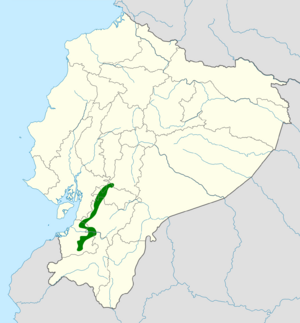El Oro tapaculo facts for kids
Quick facts for kids Ecuadorian tapaculo |
|
|---|---|
| Conservation status | |
| Scientific classification | |
| Genus: |
Scytalopus
|
| Species: |
robbinsi
|
 |
|
The Ecuadorian tapaculo is a small bird also known as the El Oro tapaculo. Its scientific name is Scytalopus robbinsi. This little bird is a type of tapaculo, which are known for being quite secretive. It lives only in a small part of southwestern Ecuador. Scientists first officially described this bird in 1997.
Contents
About the Ecuadorian Tapaculo
The Ecuadorian tapaculo is a small bird, about 11 centimeters (4.3 inches) long. Its bill is black and looks quite strong.
What Does It Look Like?
This bird's feathers, called its plumage, are mostly grey. It has a brownish color on the back of its neck and its lower back, which is called the rump. Its sides have brown stripes. The tail is a dark, blackish color. Female tapaculos have browner feathers on their undersides compared to the males.
What Does It Sound Like?
The song of the Ecuadorian tapaculo is special. It makes a series of double-notes. It repeats these notes for about a minute. This helps scientists and birdwatchers find them in the forest.
Where Does It Live?
The Ecuadorian tapaculo lives in humid forests. It prefers the thick plants and bushes found under the trees. These forests are located on the slopes of the Andes mountains in Ecuador.
Its Home in Ecuador
You can find this bird between 700 and 1250 meters (about 2,300 to 4,100 feet) above sea level. It lives in the El Oro Province, Guayas Province, and Cañar Province. It likely also lives in the Azuay Province that is between these areas.
Why Is It Endangered?
The number of Ecuadorian tapaculos is thought to be small. Sadly, this number is getting even smaller. The bird is considered an endangered species by the IUCN. This means it is at a high risk of disappearing forever.
Threats to Its Home
The main reason the Ecuadorian tapaculo is in danger is because its home is being lost. Forests are being cut down or changed. This is called habitat loss. When forests are broken into smaller pieces, it is called fragmentation. This makes it harder for the birds to find food and safe places to live.
Protected Areas
Good news is that part of the Ecuadorian tapaculo's home is protected. It lives within the Buenaventura Reserve. This reserve helps keep the forest safe for many animals, including this special bird.
See also
 In Spanish: Churrín de El Oro para niños
In Spanish: Churrín de El Oro para niños


